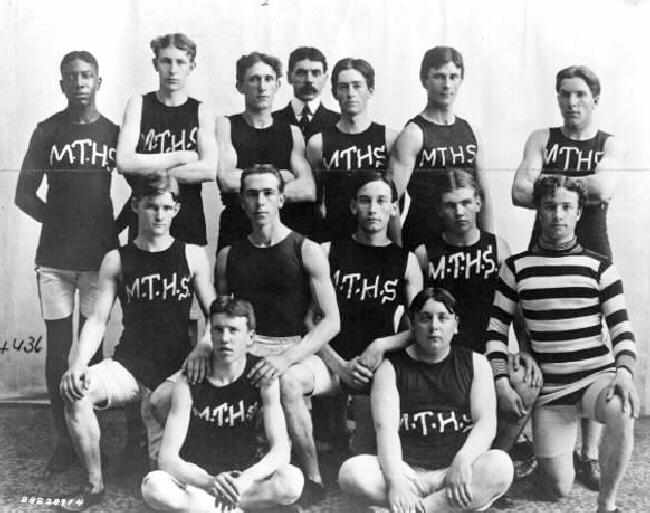
U.S. School Clothes: Emmerich Manual Technical High School (Indiana, 1905)

Figure 1.-- Here is the Emmerich Manual Technical High School Football Team, Indianapolis, Indiana, in 1905. The uniforms are quite different from modern football uniforms. Notice that there is no padding at all. The boys wear light-colored shorts (maybe white), and black sleeveless jerseys with the highschool initials on the chest, almost like basketball or track uniforms.
|
|
Here is the Emmerich Manual Technical High School Football Team, Indianapolis, Indiana, in 1905. The uniforms are quite different from modern football uniforms. Notice that there is no padding at all. The boys wear light-colored shorts (maybe white), and black sleeveless jerseys with the highschool initials on the chest, almost like basketball or track uniforms. We know very little about the school at this time.
The School
Weknow very little about the Emmerich Manual Technical High School, except that it was a technical school and located in Indianapolis, Indiana.
Technical Schools
Relatively few youths attended high school in the early 1900s. Most children finished school at the 8th grade. Most high schools had academic programs. There were also some technical schools. This is something that we know very little about at this time. Manual Training schools were technical high schools that taught boys various trade skills (metal work, carpentry, machine shop work, industrial skills), preparing them, usually, for jobs in industry. These boys were not academically inclined and were not being prepared for college. They tended to be for boys only.
The Team
Here is a Emmerich Manual Technical High School sports team in 1905. The portrait was labeled the football team. The uniforms are quite different from modern football uniforms. Notice that there is no padding at all. The boys wear light-colored shorts (maybe white), and black sleeveless jerseys with the highschool initials on the chest, almost like basketball uniforms. Their coach stands in the back row wearing a white shirt, tie, and suit. Their captain is at the right wearing a long-sleeved black and white striped jersey. Black and white seem to be the school colors. I m not positive, however, that this is the football team. The uniform looks inapporpriate for football. It is possible that the image was mislabeled. Or perhaps the portrait was taken after the football season. Our contributor writes, "It seems strange to me that boys would actually play football in this light-weight uniform, but there would be no reason to photograph the team in this uniform if it were not their actual uniform for games. Maybe highschool football in 1905 was much less physical than it is today. Do you have an opinion about this?" Indeed I do have an opinion. I think football was probably more physical at the time, although many of the players may not have been as large as modern players. I have never seen a football team dressed like this. But our reader is correct, sports teams are normally photographed in their playing uniforms. I think that there is a possibility that the image may have been mislabeled. Another reader writes, "It appears to be a track team rather than a football team. Look at the shoe in the first row. There are no socks which implies trtack and field rather than any other sport." This isd a good point. As far as I know, football uniforms involved heavy socks and shoes, often called boots.
Integration
Interestingly, for 1905, the team is racially integrated. Segregation at the time was not limited to the South. I'm not sure just what the system was in Indianapolis. There is one black boy on the team (back row, left). A reader writes, "Indiana schools had been
by 1905. There was some segrgation in the 1920's coincident or as a result of the rise of
the Ku Klux Klan." The Klan was especially influentional in Indiana during the 1920s. Segregation laws varied by state. In the South, segregated schools were required by law throughout the state. In the North and West the situation was more varied and changed over time. I beieve in Indiana that it was up to the local school district. Here economics was a factor. Having two school systems was costly. Thus it was not practical in many counties with small black populations. Indianaspolis at the time had a small black population.
HBC

Related Chronolgy Pages in the Boys' Historical Web Site
[Main Chronology Page]
[The 1900s]
[The 1910s]
[The 1920s]
[The 1930s]
[The 1940s]
[The 1950s]
[The 1960s]
[The 1970s]
[The 1980s]
[The 1990s]
[The 2000s]
Navigate the Relate Boys Historical Clothing Style Pages
[First Communion]
[Confirmation]
[Long pants suits]
[Short pants suits]
[Kneepants]
[Knickers]
[Kneesocks]
[Long stockings]
[Eton suits]
[Jacket and trousers]
[Button-on clothing]
[Blazer]
[School sandals]
[Bangs]
Navigate the Boys' Historical Clothing School Uniform Pages
[Main U.S. individual school page]
[Main U.S. individual school chronology page]
[Main National School Uniform Page]
[Australia]
[England]
[France]
[Germany]
[Ireland]
[Italy]
[Japan]
[New Zealand]
[Poland]
[Singapore]
[Scotland]
[Singapore]
Navigate the Boys' Historical Clothing Web Page
[Return to the Main sports uniform page]
[Introduction]
[Activities]
[Biographies]
[Chronology]
[Clothing styles]
[Countries]
[Girls]
[Bibliographies]
[Contributions]
[FAQs]
[Glossaries]
[Satellite sites]
[Tools]
[Boys' Clothing Home]
Created: 12:33 AM 5/31/2005
Last updated: 7:01 PM 5/31/2005




